Last updated on October 14, 2023
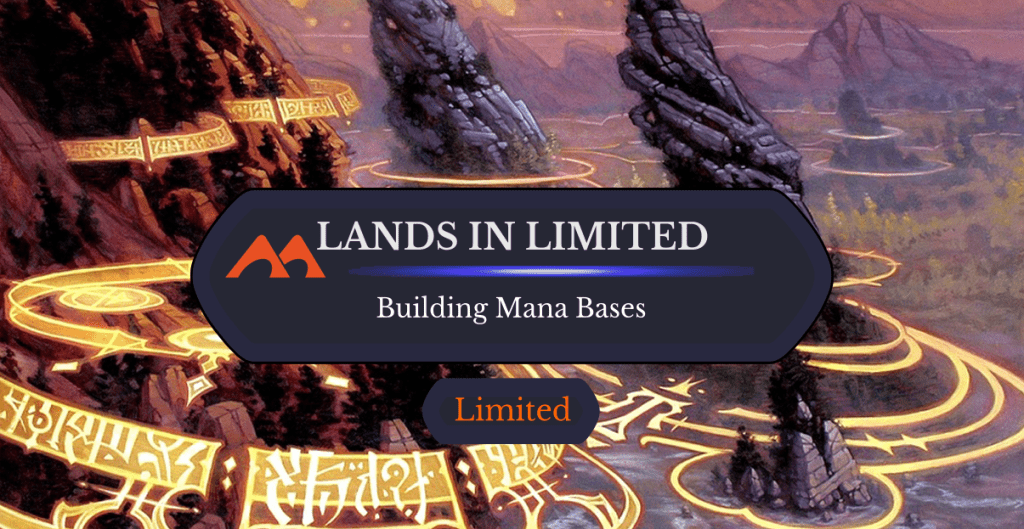
Lay of the Land | Illustration by Chuck Lukacs
Have you ever drafted a deck or built a sealed pool and just let Arena or MTGO tell you what basic lands you should run? What happens when you go to your local store to do your first in-person Draft and you don’t have an algorithm telling you what to do?
Building the mana base for your Limited deck can be the key to winning or losing. How do you do it properly? How do you splash cards into your deck, and how do you build mana bases for 4- or 5-color decks?
Let’s start with some basics (pun very much intended)!
How Many Lands Should my Limited Deck Play?
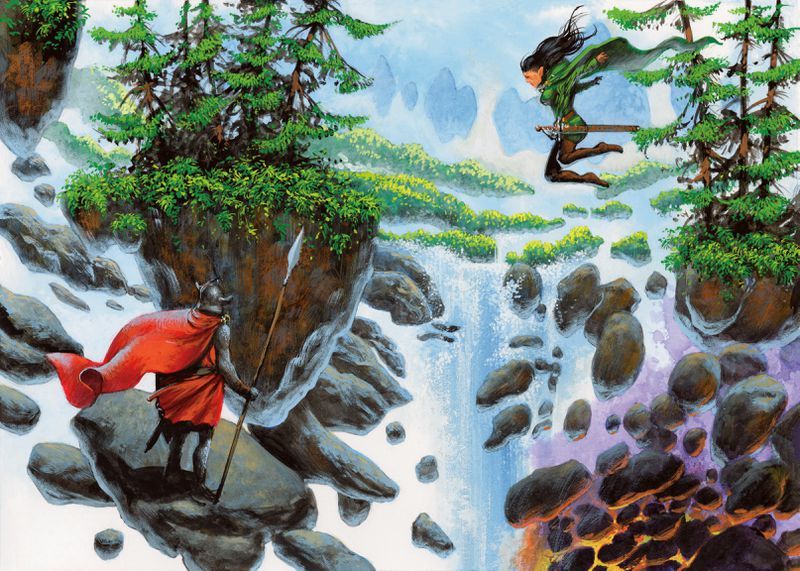
Evolving Wilds | Illustration by Brian Snoddy
It's been a long-held belief that you should always run 17 lands in your 40-card Limited decks, and that logic holds true even today. This is the best way to guarantee a good spread of lands in most of your games.
But there are some notable exceptions, like the following corner cases:
- If you have a very low-curve creature-based aggro deck, you can run fewer lands. If my aggro deck is all 2-drops, 3-drops, and just a couple 4-drops with nothing more expensive than that, I’ll often cut the 17th land in favor of another spell.
- If you’re running short on playables, playing an 18th or even 19th land is often more useful to you than forcing a terrible 22nd or 23rd nonland card into your deck.
- Sometimes a specific Draft format lends itself well to a different land count. For example, landfall was so prevalent in the original Zendikar set that decks often played around 19 lands to make sure you could trigger the effects more often. In Ikoria, the Boros () cycling deck was so powerful and drew so many cards that it often played only 12 or 13 lands.
When in doubt, stick to 17 lands and you should be fine. Now you need to figure out how many lands of each color to play. But first…
What Is a Color Source?
When building a Limited mana base, you need to make sure that you have enough sources of mana for each of your colors. Any card in your deck that can provide mana of a particular color without costing that mana in the first place can be considered as a color source.
Here are some examples:
- Basic lands are, by definition, color sources for their own colors. A Plains is a white source, an Island is a blue source, and so on.
- Dual lands are color sources for both colors of which they produce mana. Tranquil Cove is a white source and a blue source.
- Evolving Wilds is a card that frequently appears in Draft sets, and it can be considered an additional source of every color that you play a basic land of.
- A card like Llanowar Loamspeaker can tap for any color, but we can’t consider it a green source because it costs green to cast.
- Mana rocks like Network Terminal can be considered as roughly equal to a color source for each color. The more expensive they get, the less reliable they are. A card like Meteorite isn’t good enough to be considered a reliable color source.
These distinctions are important. You want to make sure your mana base contains enough color sources for each of your colors when building it.
How Many Sources of Each Color Do I Need To Play?
You should typically look to play at least eight or nine sources of your deck’s main colors. Why? Math. More specifically, probabilities.
You may have heard of the term “hypergeometric distribution.” Probability distributions are basically mathematical formulae that let you determine the odds of a particular event happening.
In this case the hypergeometric distribution lets you calculate the odds that you’ll draw a specific card from your deck given some number of attempts (essentially, cards drawn). It’s a complicated formula, but one that’s easy to use thanks to calculators like this one. You can tell this calculator things about your deck and it'll tell you the odds that you’ll draw what you want in however many tries.
To translate, you need to input the following information into the calculator to try it for yourself:
- Population size = Number of cards in your deck.
- Number of successes in population = Number of color sources in your deck.
- Sample size = How many cards have you drawn (for example, 7 if you want to find it in your opening hand).
- A number of successes in sample = How many sources do you need to find, in this case just one will do.
From there hit “Calculate” and the number you want to look at is the final one, for P(X≥1): the probability that you’ll find at least one of your sources (an = would mean you want exactly one). Using this you can determine the probabilities of a color source appearing at least once in your opening hand based on how many you put in your deck.
This gives you the following odds (the results have been converted to percentages):
| Sources in Deck | Probability |
|---|---|
| 1 | 17.5% |
| 2 | 32.3% |
| 3 | 44.8% |
| 4 | 55.2% |
| 5 | 63.9% |
| 6 | 71.1% |
| 7 | 77.1% |
| 8 | 81.9% |
| 9 | 85.9% |
| 10 | 89.1% |
| 11 | 91.6% |
Let’s assume a 2-color deck. If you don’t see one of those colors in your opening hand, that’s reason enough to mulligan and you want to minimize that. What this table shows is that dropping color sources drops the chance of seeing that source significantly at a certain point. If you run eight or nine sources of those main colors then you should see them in at least four in every five games. The odds drop significantly once you start to drop to seven or six sources.
A few lessons from this:
- You probably need at least eight sources of a main color to make sure you see that color in your opening hand.
- Once you hit 10 color sources, adding extra sources does very little to improve the odds of seeing this color. This will become relevant very shortly.
- Whenever you add lands to your deck that isn’t of your main colors, like splash colors or colorless lands like Tocasia's Dig Site, you reduce your chances of seeing your main colors quite significantly.
Land Bases for Monocolor Decks
If you’re mono-white you can just play 17 Plains and be done with it, right? Sure, but the table above reveals something very interesting: after 10 color sources, each extra one does very little to increase the chance of seeing it.
In fact, if you go all the way up to 17 Plains, your chances only go up from 89.1% at 10 sources to 98.7% at 17. You have a lot of room to play around with colorless lands and splash colors, and these odds suggest that it would be in your best interests to do so.
You could play one or two powerful off-color cards and run six or seven sources of that color if you only really need 10 or 11 sources of your monocolor to reliably see it, making the splash very easy.
Land Bases for Dual Color Decks
This is where most Limited decks land. Based on the math above, a 9/8 split of the two colors is ideal. The 9 should go in favor of the color you have more cards of, or the one that has more cheap cards in your deck (because you need to see it early).
You would, of course, like to get these numbers higher, so any dual lands are appreciated. Running an 8/8 split with one copy of Evolving Wilds gives you nine sources of each color, which is pretty awesome.
I often see players look at their decks and see that they have 16 cards of one color and seven cards of the other and assume that they should skew the mana base accordingly. This isn’t a good idea.
Given that the odds of seeing a color don’t go up by a significant amount when you increase from 10 sources to 11 sources, you just don’t need to do this. I pretty much always stick to a 9/8 split, but I can see there being reasons for going 10/7 with certain decks. Going to 11/6 harms your chances of seeing your secondary color while not actually benefiting your primary one.
Land Bases for a Dual Color Deck with a Splash Color
I've used the term splash quite a bit, but what do I mean by it? A splash is typically a card that you play that isn’t one of your main colors. The more cards you splash in your deck, the less consistent your deck becomes because you need to run enough color sources to be able to cast them.
I’d only ever recommend splashing in the following circumstances:
- The card you want to splash is a silly bomb rare, like Myrel, Shield of Argive, that’s capable of winning the game by itself.
- The card you want to splash is extremely impactful, like a powerful removal spell.
- Your deck is missing a key piece, but you’ve picked one up in another color. For example, your Rakdos () aggro deck could be missing any kind of interaction but you have a white combat trick.
- Splash cards should pretty much never require more than one color source of the off-color to be used. Finding one color source isn’t too hard, but finding two is incredibly difficult and skews your mana base too much.
How Many Color Sources Do You Need?
Briefly turning back to the hypergeometric distribution, you might want to know how many color sources you need to reliably see your splash color. You don’t need it to appear in your opening hand, but let’s say you want to see it by turn 6, so you’ve drawn five extra cards. The odds look something like this:
| Sources in Deck | Probability |
|---|---|
| 1 | 30% |
| 2 | 51.5% |
| 3 | 66.8% |
| 4 | 77.6% |
A lot of players run just two off-color sources so you see one in just over half of your games by turn 6. The more you can include, the better your chances. This goes up a lot just by getting to the third or fourth source.
My general rule is that I want three sources of my splash color. If I can’t get to three sources, I don’t run the splash. If you're looking to splash two cards, you want this number to go up to five sources.
The need to get to three mana sources is exactly why mana fixing is very important for your deck. If you play a 7/7/3 split of lands with the 7s being your main colors and three being your splash, you’ve massively hurt the consistency of your deck and made it a lot less likely that you’ll find one of your main colors.
But with two Evolving Wilds you can run 7/7/1 with the two fetches, which gives you nine sources of your main colors and three of your splash. That’s way more consistent!
Is the Splash Worth It?
There’s a common misconception is that you need dual lands for your splash color to be worth it. This isn’t true.
Let’s say your deck is Simic () and you have a red card to splash. Swiftwater Cliffs and Rugged Highlands are great lands because they provide one source of a main color and one for your splash. Any copies of Thornwood Falls are also great because it lets you run more basics to cover your splash by giving you more sources of your main colors.
A Simic deck splashing for red could very easily have three copies of Thornwood Falls, three Mountains and a 6/5 split of Islands and Forests, giving a total of nine and eight sources of the main colors of the deck. All that’s important is to lay out the mana fixing you have, count how many sources you already have, and try to get your main colors up to eight or nine and your splash colors up to three.
If you don’t have enough mana fixing to do it then you should consider dropping the splash altogether.
Land Bases for a Triple Color Deck
I’d generally recommend sticking to two colors in most Limited formats, but it’s often a good call to run three colors when a format has abundant mana fixing. Some formats actively encourage it, like Khans of Tarkir or New Capenna, but it’s also been very possible in other multicolor formats like Guilds of Ravnica or Strixhaven.
A lot of the rules I've already laid out still apply to 3-color decks. Even though you have a lot of cards in each color you should still be able to identify one or two of these as your main color(s). For instance, if you have an Esper () deck with 10 blue cards, 5 white cards, 5 black cards, and 3 multicolor cards (all of which are blue), then clearly blue is your main color.
You should want to make sure that you have at least eight or nine sources of blue before looking at anything else, no matter how your mana base is built.
For example, if you’ve picked up five dual lands during the Draft and three of them are blue sources, then your first thought should be that you want to add six Islands. From there you have room for six more lands, and you should spread them between white and black. If you still needed more color sources then dropping one of the Islands is a possibility, but this should at least be your starting point.
3-color decks can be hard to pull off, but the key is making sure that you draft them well. If you come out of pack 1 and know that you’re likely to end up playing a 3-color deck then you need to start prioritizing mana fixing more than you normally would.
Just ask anyone who played the Invasion block how they enjoyed their 6/6/5 mana bases. (Invasion was Magic’s first ever multicolor block, but it had little to no mana fixing despite most decks ending up as three colors. Harrow was one of the best commons in the set because of this.)
Land Bases for 4- or 5-Color Decks
4- and 5-color decks are a little specialty of mine. I love it when they come together. We saw a lot of these in sets like Kaldheim and Dominaria United, where the respective snow and domain themes really pushed players to be creative with their mana bases and make the best use of their cards.
The trick with 4- and 5-color decks is that you never actually have a deck that’s purely all of those colors. Just like with the 3-color decks above, you should still be able to identify your main colors and center your mana around them.
In Kaldheim and Dominaria United, the “5-color” archetype was actually just green and blue with splashes of the others. You often also have green cards that fix your mana, making it important to prioritize green sources in your mana base. The snow decks in Kaldheim often used Glittering Frost as a mana fixer, so you always needed to make sure this was castable before anything else.
Let’s say you’ve drafted one of these monstrous decks. You have a pile of nine dual lands and you want to figure out which kinds of basic lands you want to play. I’ll usually pull out a pen and paper to draw a quick table like this:
| White | Blue | Black | Red | Green | |
|---|---|---|---|---|---|
| Cards | 3 | 7 | 1 | 4 | 10 |
| Sources | 1 | 6 | 4 | 3 | 4 |
Let’s say this is a deck you drafted. You have 23 cards you want to play, two of which are gold cards. You picked up nine dual lands, which makes for 18 total color sources (since each dual land acts as two color sources) across the five colors, and they’ve ended up like you drew out in the table. From here you want to figure out to use your eight last land slots.
My thought process goes like this:
- Green is your first main color. You want to get to eight sources of this and you already have four, so you need to run four Forests.
- Blue is your second main color, but you already have six sources of it. You probably only need one more to help it along, so you should run one Island.
- You only have one black card, but you have four sources of black mana already, so you don’t need a Swamp. In fact, since you only need three to reliably see it, so it might be a good idea to cut one of the black dual lands in favor of another basic land.
- Your remaining colors are white and red and you have three slots remaining. You'd generally like to run at least two more Plains to make sure you have at least three white sources. The final land would be either of these, but it should probably be a Mountain because you have more red cards.
From this you can determine that you want to run four Forests, one Island, two Plains, and one Mountain. There are a lot of factors that might change this outcome, like if you have some Evolving Wilds or nonland cards that give you extra color sources.
You’ll note that the splash colors still have fewer than the ideal number of mana sources. This is just the nature of running decks like this. When at all possible you want to keep the splashed colors to a minimum to improve the overall consistency of the deck.
Wrap Up
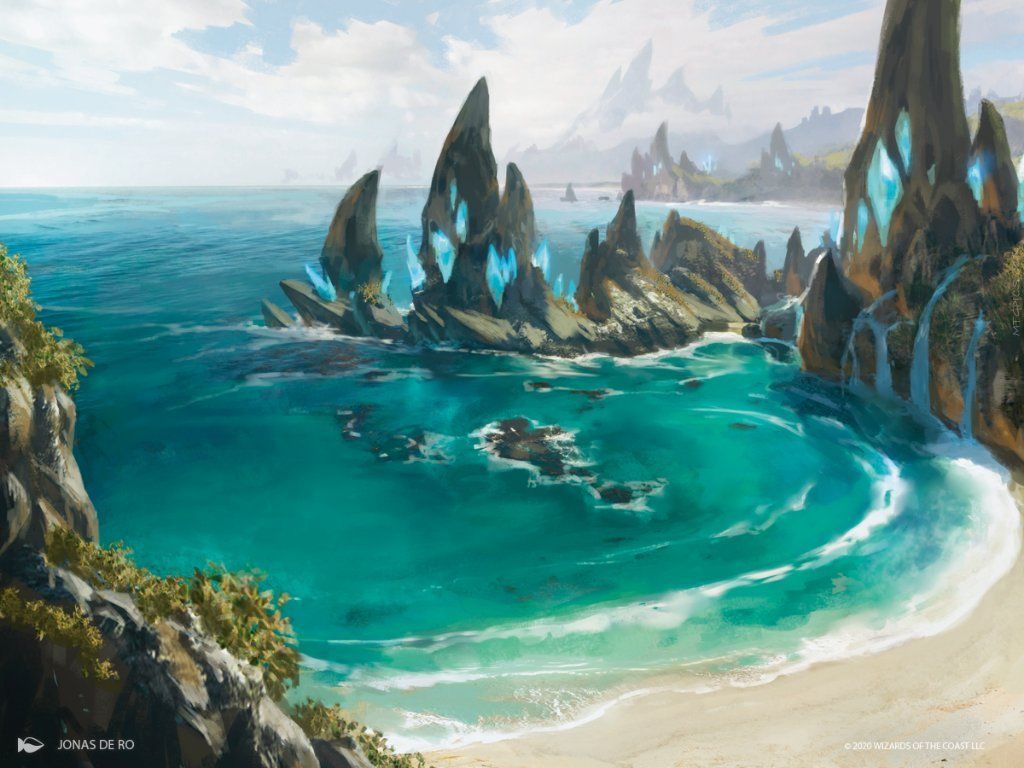
Tranquil Cove | Illustration by Jonas De Ro
Sorry if some of this got a bit technical, but I really wanted to give some extra detail as to why some of these conventions exist in Magic. Math really is everywhere (cue groans).
Has this guide helped to fix your deck-building strategies? Got a burning question? Let me know in the comments below or over in the Draftsim Discord.
Until next time, take care of yourselves!
Follow Draftsim for awesome articles and set updates: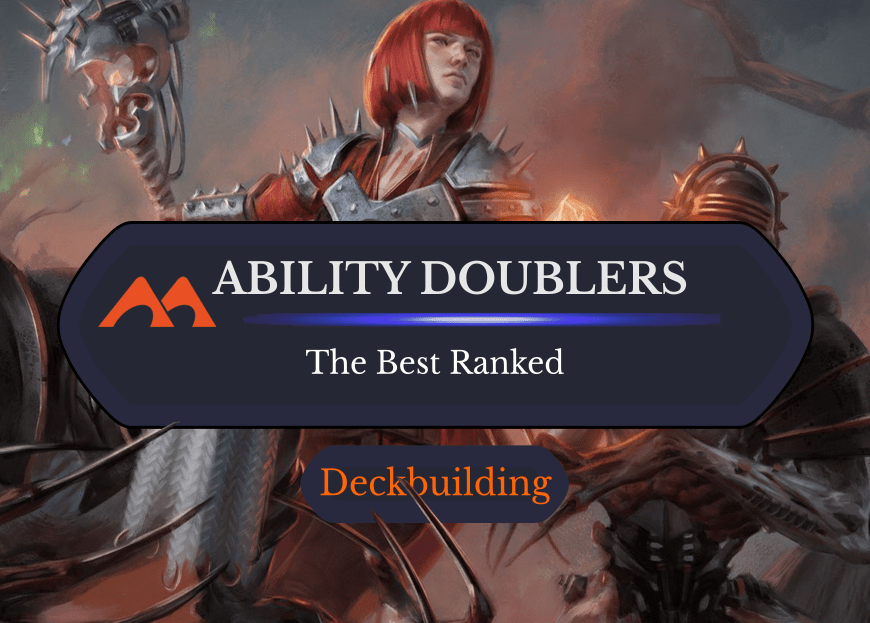
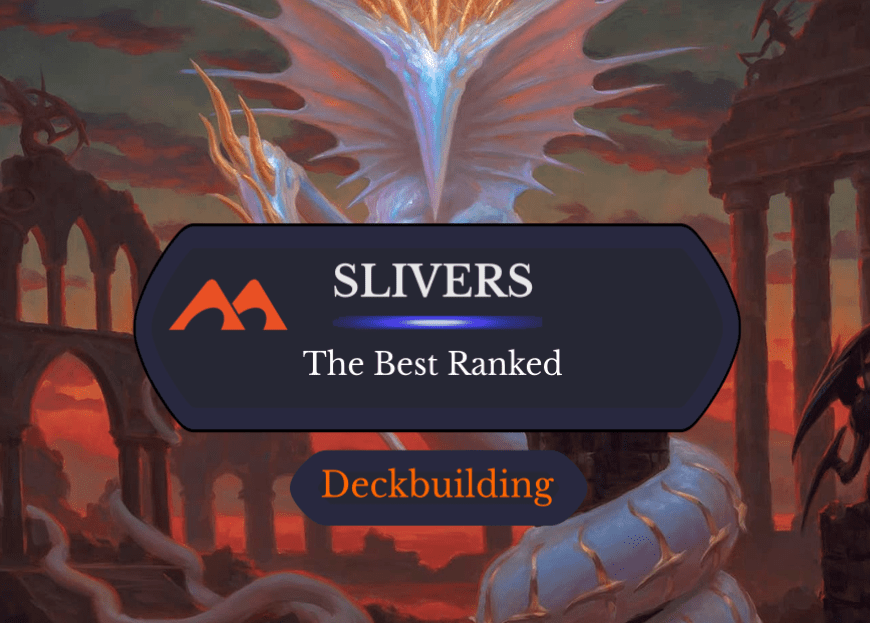
1 Comment
I think one slight “flaw” of the calculation is that drawing lands from multiple colours isn’t independent. For instance getting 1+ lands from 8 sources is indeed at 81.9% but getting 1+/1+ from 8/8 sources in a 2-colour setup reduces the probability to 65.7%. If we then also ask for getting at least 3 lands overall (yes, one can sometimes play with two lands, but let’s just say we want 3+ overall) then we could start by computing the probability to get exactly k lands in our first 7. This yields 1.9% (0) 11.6% (1) 27.4% (2) 31.9% (3) 19.8% (4) 6.5% (5) 1% (6) 0.1% (7) and then compute the conditional probability to get 1+/1+ out of e.g. 8/8 provided that we go at exactly k lands into our starting hand. For example, for 3 lands we have an 80% chance that those lands are not 0/3 or 3/0 out of 8/8. We can then use this to calculate probabilities like e.g. P(1+/1+ and 3+ altogether from 8/8) which reduces further to ~51.2% down from the 65.7% given above. Splashing an additional colour could be incorporated as well. E.g. with 8/8/1 (and two main colour lands providing us splash colour mana) we get 54.2% for 1+/1+ and 3+ overall while with 7/7/3 this reduces to 48.9%. Now we could go further and include mulligans as well but I guess that’s going too far 😀
Add Comment